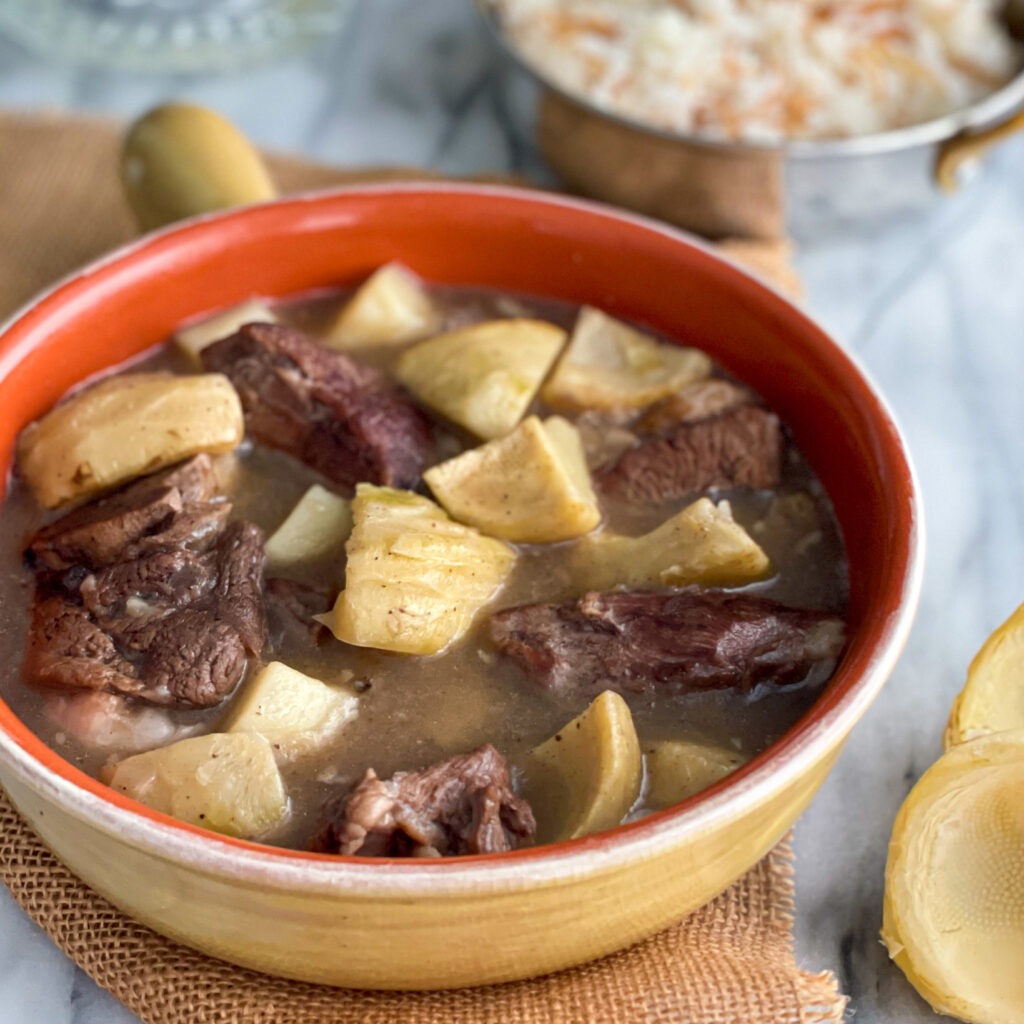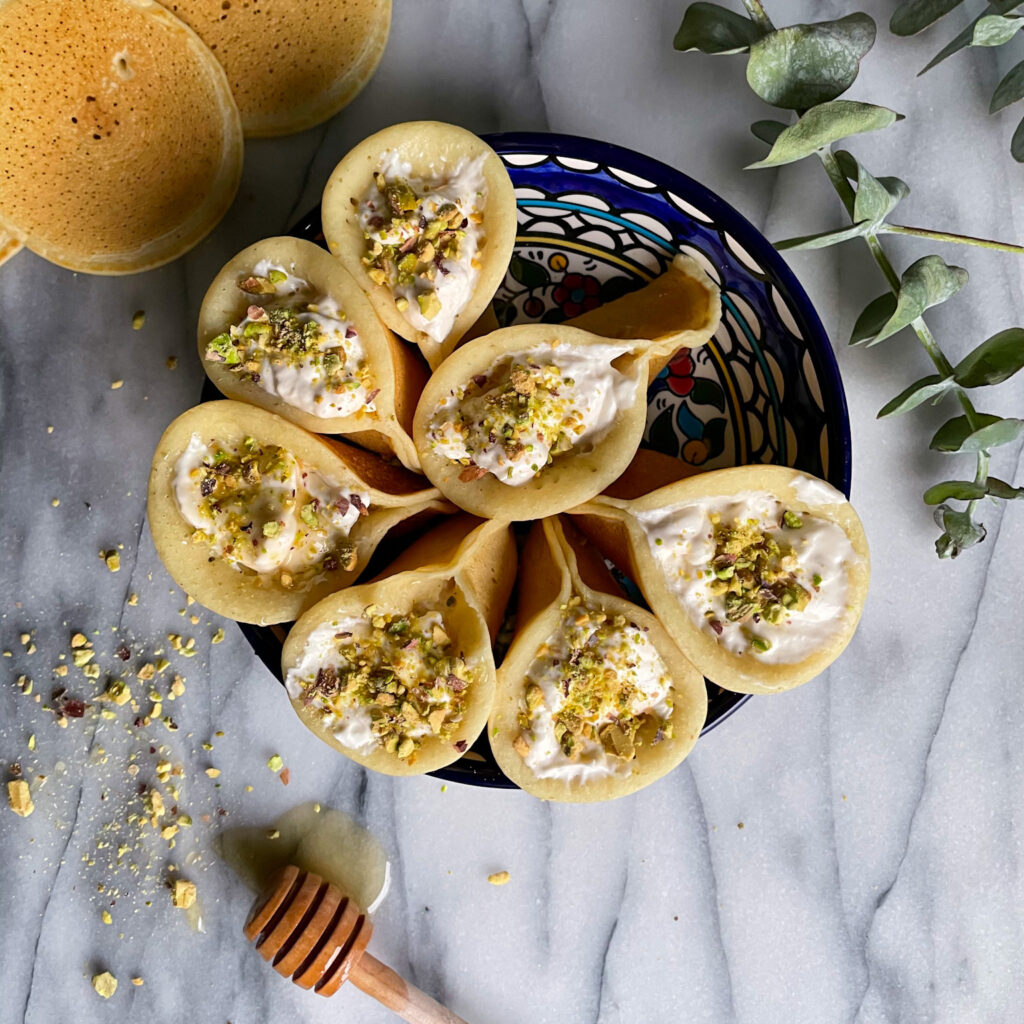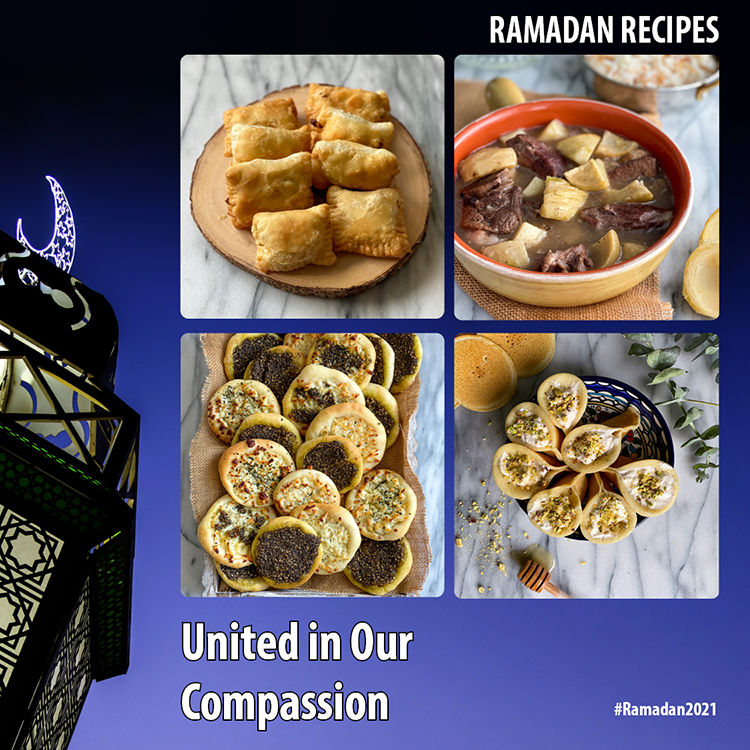Ramadan Weekly Recipe Collection 3
Our third Ramadan Recipe collection is ready for your family and friends to enjoy! This week, UPA supporter and food blogger, Nida Khalaf, offers four new recipes and videos of her making Manakeesh and Sambousek.
MANAKEESH
Manakeesh is a classic Levantine flatbread typically eaten for Sohour in Ramadan. Manakeesh are usually baked with a variety of toppings such as Nabulsi or halloumi cheese, olive oil & zaatar or a combination of both. There is nothing like freshly baked Manakeesh to make your whole house smell & feel warm. In Palestine, as well as many other cities in the Levant area, Mankeesh are a weekend favorite. People would line up to pick up freshly baked wood oven Manakeesh from the local bakeries.
Prep: 30 mins
Cook: 10 mins
Ingredients:
The dough:
– 3.5 cups flour
– 1.25 cups warm water
– 1 egg
– 3 tbsp dried milk (if not available omit)
– 1 tbsp traditional yeast
– ½ cup vegetable oil
– 1 tsp salt
– 1 tsp sugar
– 2-3 tbs olive oil
Za’atar and Cheese Toppings:
– 1 cup Za’atar
– ½ cup olive oil
– 2 cups grated Nabulsi cheese
Method:
– In a cup, mix the yeast, sugar with warm water set aside until the yeast activates (around 10 mins).
– In a mixing bowl, add the dough ingredients, the yeast and remaining water. Knead for 10-15 mins or until the dough forms (you’re looking for a soft dough, it’s ok if it sticks a tiny bit to your fingers).
– Drizzle some olive oil in a large bowl, add the dough, cover it with a towel. Let it rest for 1 – 1.5 hours until the dough doubles in size.
– Cut the dough into equal size balls (the size of golf balls) and let them rest for 10-15 mins.
– While the dough balls rest, prepare the toppings. For Za’atar, simply mix the Za’atar and olive oil until you get a smooth oily paste. As for the Nabulsi cheese, just grate it.
– Preheat your oven to 400F and prepare a baking tray covered with parchment paper. Place the balls on the parchment paper, press with your fingers to form mini discs.
– Spread the Za’atar paste, or cheese toppings on top, and you can also combine both! Don’t use too much zaatar a tsp for each disc is sufficient.
– Bake for 8-10 mins or until nice and slightly golden around the edges.
Enjoy with tomato wedges & mint tea! Sahtain & Bon Appetite.
SAMBOUSEK
Sambousek is a Ramadan appetizer favorite! They are made with either meat or cheese! I personally prefer my Sambousek with cheese, and below is a simple and fun recipe! Usually, Sambousek is a in crescent shape, but these squares are much easier and faster to make!
Prep: 10 mins
Cook: ~4 mins
Ingredients:
– a pack of frozen puff pastry
– 2 cups grated or finely chopped Nabulsi or Halloumi cheese
– 1.5 tbsp dry mint
– ¾ cup vegetable oil
Method:
– Take out the dough from the fridge and let it thaw for 20 mins.
– Cut the dough into small squares (approx. 4 cm2).
– Chop the cheese into small cubes and mix it with the dried mint.
– Create little pockets, stuff them with cheese, use a fork to score the edges and seal them and that will create your Sambousek.
– In a pan, heat up the vegetable oil on high, reduce the heat to medium and shallow fry the Sambousek for 2 mins on each side or until golden brown, place on a paper towel to allow the oil to absorb and enjoy as an appetizer.
ARTICHOKE & LAMB STEW WITH VERMICELLI RICE

This Levantine classic is quite easy to make at home and is the perfect iftar meal as it is warm, hearty, and light. This stew is lemony and has very earthy flavours, it is served A’aa Adamha (In Arabic which means, using the lamb stock as a base with no additions such as a tomato or yogurt base). Artichoke is from the same family as A’koub, a similar earthy vegetable that’s very famous during the month of Ramadan in some regions of Palestine (e.g. Nablus) A’koub is very popular during the first week of Ramadan – depending on the season Ramdan falls in.
Akoub/artichoke are renowned for their nutritional properties and earthy flavours.
Prep: 30-45 mins
Cook: the meat 1.5 hrs, the stew 30 mins, the rice 22 mins
Enough for 3-4 people
Ingredients:
– 800 g of lamb pieces (preferably lamb shoulder)
The meat spices and flavoring:
– 3 tbsp olive oil
– 1 tsp 7 spices or baharat (if not available, use allspice and add ¼ tsp nutmeg, 2 pieces of cloves, and 3 cardamom pods)
– 4 bay leaves
– 3 cloves of garlic
– ½ onion cut into large wedges
– ½ tsp salt (to taste)
– 6 cups of water
– 2 bags of frozen artichoke hearts/bottoms, a total of 750g
– 3 tbsp olive oil
– ½ tsp salt, ¼ tsp pepper (to taste)
– 1 small potato (optional)
– ¼ onion roughly chopped into cubes
– 2 tbsp corn starch dissolved in 2 tbsp cold water (to prevent it from lumping)
– 1.5 Tbsp lemon juice
The vermicelli rice:
– 1/4 cup vermicelli
– 1.5 cups rice
– 1/4 tsp Salt
– 2 cups water
– 2 tbs olive oil
Method:
– In a medium-size stew pot, add the olive oil, and on medium-high brown the lamb pieces. This should take around 10 mins.
– Add the meat spices and flavorings and let them cook for additional few mins.
– Add the water and bring it to a boil. Use a spoon to scrape off any excess foamy fat that surfaces.
– Reduce the heat to medium-low and let the meat cook covered for 1.5 hours or until it becomes very tender. Once the meat is ready, add the salt.
– Once the meat is cooked, using kitchen tongs, remove the lamb pieces. Use a strainer to drain the meat stock. And set it aside.
– Prepare the veggies as the meat cooks. Slice each artichoke heart into 4 equal pieces; if using potatoes, cut it into cubes, and roughly chop the onion into cubes.
– In a pan, add olive oil on medium-high, add the veggies, and let them cook for 10-15 mins until they soften and get a nice color, occasionally stir to ensure all sides cook – season with salt and pepper.
– Using the stew pot, add the meat, veggies, and lamb stock and let them cook on medium for 10 mins; add the corn starch and lemon juice and let them cook for additional 20 mins.
– Prepare the rice: add some olive oil and cook the vermicelli until it gets a nice golden color. Add the rice, let it cook with the vermicelli for a minute; add the boiled water, and let it simmer on high for 2 mins. Then cover the pot with a lid and reduce the heat to low and let the rice cook for 20 mins.
– Plate and garnish with some fresh parsley (optional) and enjoy!
QATAYEF ASAFEER WITH ESHTA, PISTACHIO AND HONEY

Treat family & friends to a comforting, iconic Iftar dessert. Qatayef is a dessert similar to pancakes stuffed with white cheese (Nabulsi or Akawi), or Eshta! Serve the Qatayef with a drizzle of ground pistachios and syrup (honey or ater). During Ramadan, Qatayef is a must-have, and bakeries all over the Arab world sell ready-made Qatayef or Qatayef dough.
Regular Qatayef and Qatayef Asafiri are the two most popular varieties. Qatayef Asafiri are smaller and are served without cooking.
Prep: 30 mins
Cook: 25 mins
Ingredients:
– 2.5 cups flour + ½ cup semolina (if not available, use flour only)
– ½ tsp instant yeast
– ½ tsp baking soda
– 1 tsp vanilla extract or powder
– 1 Tbsp sugar
– ¼ tsp salt
– 3.75 to 4 cups of warm water
– 2-3 cans of Estha (I use Puck creamy product)
– ¼ cup crushed pistachio
– honey (to taste)
Method:
– In a mixing bowl, add the dry ingredients and the water and, using a hand whisk, whisk until well combined. This should be similar to a pancake mix. Cover with a towel and let it rest for 30 mins.
– Using a pancake pan or griddle, heat it on high, then reduce the temperature to medium. Pour the Qatayef mix and let them bubble until fully dry on top (this will take around 1-2 mins) you are looking for 2-3 cm diameter pancakes, make sure not to flip them while they cook! Unlike pancakes, Qatayef cook on one side only, this will allow them to seal!
– Place the ready Qatayef on a kitchen towel and cover with a towel until you finish the entire batter.
– Fill the Qatyef with Eshta, seal the side halfway through, drizzle with pistachio and enjoy with a generous touch of honey!
ABOUT NIDA KHALAF
Nida Khalaf was born and raised in Ramallah, Palestine. She later moved to North America to pursue higher education and settled in Toronto. For Nida, food, family, and culture are intimately tied up; food serves as a memory and a human connection. Preserving recipes passed down from her loved ones and sharing them with her own unique twist, gives her a wonderful sense of nostalgia for her childhood home and the people with whom she shared the cooking and dining experience. Follow Nida on Instagram!

